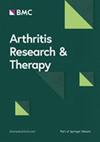Increased serum level of IL-6 predicts poor prognosis in anti-MDA5-positive dermatomyositis with rapidly progressive interstitial lung disease
IF 4.9
2区 医学
Q1 Medicine
引用次数: 0
Abstract
Anti-melanoma differentiation-associated protein 5 antibody-positive dermatomyositis (anti-MDA5-positvie DM) is a subtype of dermatomyositis with a poor prognosis, characterized by rapidly progressive interstitial lung disease (RP-ILD). The study aims to investigate the significance of serum cytokines profiles and peripheral lymphocytes in predicting prognoses of anti-MDA5-positvie DM with RP-ILD. Furthermore, it seeks to analyze longitudinal data of lymphocytes during hospitalization to identify distinct trajectories and cluster patients accordingly. A total of 168 patients with anti-MDA5-positive DM were enrolled in this retrospective study from two cohorts. Univariate and multivariate Cox regression analyses were conducted to determine the predictors of 6-month all-cause mortality and RP-ILD. Group-based trajectory modeling (GBTM) was employed to model the trajectories of longitudinal peripheral lymphocytes. In the multivariate Cox regression analysis, IL-6 ≥ 13.41pg/mL, lymphocytes < 0.5 × 109 /L, lymphocytes from 0.5 to 1.0 × 109 /L, older age, and elevated LDH were identified as independent predictors of 6-month all-cause mortality. Furthermore, IL-6 ≥ 13.41pg/mL, lymphocytes < 0.5 × 109 /L, and lymphocytes from 0.5 to 1.0 × 109 /L were found to be independent predictors of RP-ILD. Additionally, three trajectory groups of lymphocytes within the first week after admission were established based on GBTM. These groups included: Group 1, with low-level of lymphocytes that declined; Group 2, with medium-level of lymphocytes that slightly rose; and Group 3, with high-level of lymphocytes that rose. Notably, group 1 showed the highest mortality (90.7%) and all experiencing RP-ILD. Increased expression of IL-6 in lung tissues was observed in two cases with RP-ILD compared to two cases without RP-ILD. We also found the increased infiltration of CD4 + and CD8 + T cells, particularly CD8 + T cells, in lung tissues from patients with RP-ILD. Our study demonstrated that increased level of serum IL-6 (≥ 13.41pg/mL) and severe lymphopenia were promising predictors of 6-month all-cause mortality and the occurrence of RP-ILD in anti-MDA5-positive DM patients. Furthermore, tracking distinct trajectories of lymphocytes during hospitalization can be utilized to cluster patients.血清 IL-6 水平升高可预测抗 MDA5 阳性皮肌炎伴快速进展性间质性肺病患者的不良预后
抗黑色素瘤分化相关蛋白5抗体阳性皮肌炎(anti-MDA5-positvie DM)是一种预后不良的皮肌炎亚型,以快速进展性间质性肺病(RP-ILD)为特征。本研究旨在探讨血清细胞因子谱和外周淋巴细胞在预测抗MDA5-positvie DM合并RP-ILD预后中的意义。此外,该研究还试图分析住院期间淋巴细胞的纵向数据,以确定不同的轨迹,并据此对患者进行分组。这项回顾性研究共纳入了168名抗MDA5阳性DM患者,他们来自两个队列。研究人员进行了单变量和多变量Cox回归分析,以确定6个月全因死亡率和RP-ILD的预测因素。采用基于组的轨迹模型(GBTM)来模拟纵向外周淋巴细胞的轨迹。在多变量 Cox 回归分析中,IL-6 ≥ 13.41pg/mL、淋巴细胞< 0.5 × 109 /L、淋巴细胞从 0.5 到 1.0 × 109 /L、年龄较大和 LDH 升高被确定为 6 个月全因死亡率的独立预测因素。此外,IL-6 ≥ 13.41pg/mL、淋巴细胞< 0.5 × 109 /L、淋巴细胞从 0.5 到 1.0 × 109 /L也是 RP-ILD 的独立预测因子。此外,还根据 GBTM 确定了入院后第一周内淋巴细胞的三个轨迹组。这些组别包括第一组,低水平淋巴细胞下降;第二组,中等水平淋巴细胞轻微上升;第三组,高水平淋巴细胞上升。值得注意的是,第 1 组死亡率最高(90.7%),所有患者都出现了 RP-ILD。与两例无 RP-ILD 的病例相比,两例有 RP-ILD 的病例肺组织中 IL-6 表达增加。我们还发现,RP-ILD 患者的肺组织中 CD4 + 和 CD8 + T 细胞浸润增加,尤其是 CD8 + T 细胞。我们的研究表明,血清 IL-6 水平升高(≥ 13.41pg/mL)和严重淋巴细胞减少症是抗 MDA5 阳性 DM 患者 6 个月全因死亡率和 RP-ILD 发生率的预测因子。此外,跟踪住院期间淋巴细胞的不同轨迹可用于对患者进行分组。
本文章由计算机程序翻译,如有差异,请以英文原文为准。
求助全文
约1分钟内获得全文
求助全文
来源期刊

Arthritis Research & Therapy
RHEUMATOLOGY-
CiteScore
8.60
自引率
2.00%
发文量
261
审稿时长
14 weeks
期刊介绍:
Established in 1999, Arthritis Research and Therapy is an international, open access, peer-reviewed journal, publishing original articles in the area of musculoskeletal research and therapy as well as, reviews, commentaries and reports. A major focus of the journal is on the immunologic processes leading to inflammation, damage and repair as they relate to autoimmune rheumatic and musculoskeletal conditions, and which inform the translation of this knowledge into advances in clinical care. Original basic, translational and clinical research is considered for publication along with results of early and late phase therapeutic trials, especially as they pertain to the underpinning science that informs clinical observations in interventional studies.
 求助内容:
求助内容: 应助结果提醒方式:
应助结果提醒方式:


